Solutions to Protect Our Lakes & Streams
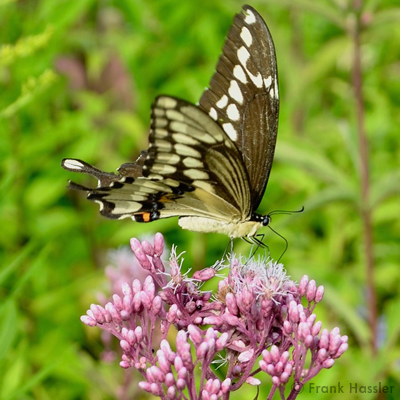
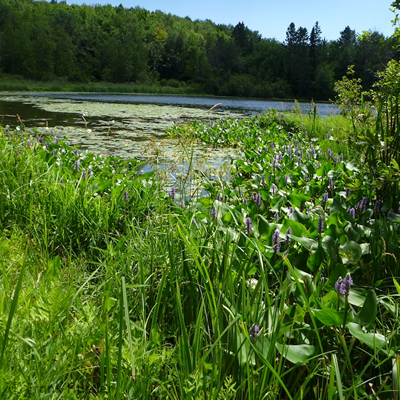
A natural shoreline protects from erosion and provides wildlife habitat.
Degraded Shorelines: Dirty Water
An eroded shoreline is more than just an eyesore. Exposed soil leads to dirt and debris washing into our lakes and streams, reducing water clarity. Some of this silt settles to the bottom, literally mucking up fish spawning beds and the habitat for bottom dwelling species. Residential runoff can wash into bodies of water.This warm water is often contaminated with fertilizers, pesticides and petrochemicals. This warm, dirty water increases water pollution and nutrient loads which leads to species loss, algae blooms, masses of aquatic weeds and potentially, fish die-offs.
The causes of shoreline erosion are many. Loss of the original vegetation on the shoreline, and emergent vegetation just off shore are big ones. Native plants develop communities with deep and intertwining root systems that reinforce and stabilize the soil. Many people choose to maintain lawn right up to the water’s edge. Unfortunately, shallow-rooted lawn grasses are easily undercut. Heavy boat traffic also results in more wave energy impacting the shore. Without the aquatic emergent vegetation to dispel the force of each wave, the shore is even more vulnerable to this increased wave action. Rip rap installations have been the traditional way to address shoreline erosion. But this is really only a temporary solution, expensive to install and requiring replacement more often than you would expect.

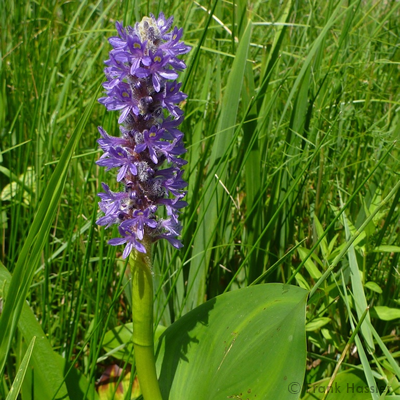
A shoreline buffer strip planting 1-year after planting (left), and pickerelweed, a common emergent plant (right).
A Natural Solution
Good Oak can provide a solution: Regrade and repair the damaged shoreline and return native plants to stabilize it in the long-term. This system rebuilds the way nature had long kept our lakes clean and shorelines stable: strong-rooted native plants. Once established, this shore line native plant community will heal itself, instead of requiring replacement like rip-rap and retaining walls. This reduces the cost of maintenance in long term. These native shoreline plantings take 2-4 years to become fully established and grow stronger, more stable, and more beautiful with time. Re-vegetating lake and stream shores with native plants is the best solution for water quality and long-term shoreline stability.
How It's Done
Every site is unique, and we can work with you to come up with the best solution for your property. Generally, we begin with regrading the shoreline itself. Often we need to add a little extra buffer right at the shoreline. For this, we stake-in a “bio-log” a large roll of dense coconut fibers. This adds structure and stability in the short-term, but will break down into soil and organic matter within roughly a decade so that plants can root into it. Another short-term “band aid” we use to help heal your wounded shore is erosion matting, composed of natural fibers, UV-biodegradable plastic netting.
In recent years the Wisconsin DNR has developed comprehensive shoreline management regulations. These are very important rules to help protect our public water resources, however they can be a little complicated and time consuming to work through. We have the experience, and the patience to work through state and local shoreline regulations for you.
A shoreline restoration project can be broken down into three distinct “zones”. We may work in one, two, or, ideally, all three of these zones to create the most comprehensive shoreline protection project.

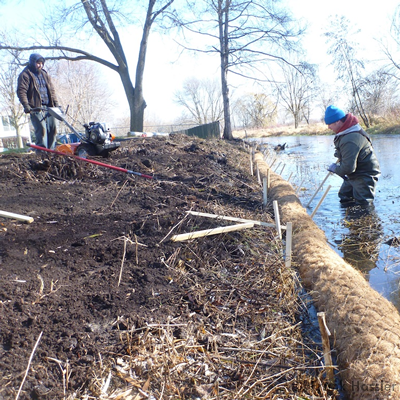
Installation of a bio-log (left) and emergent shoreline plants (right) help protect the shoreline.
The Buffer Zone
In the buffer zone, native wildflowers and grasses slow down and absorb run-off from the surrounding landscape. This keeps pollutants and lawn chemicals out of the lake. Water infiltrates into the soil where it is naturally cooled and leaves particulates and pollutants behind. From there it moves with groundwater into the lake or stream, which was the way all of our waterways were fed before development. The buffer zone plants also provide habitat for butterflies, bees, songbirds and other wildlife. Though geese can be a pest on many lawn-grass shorelines, they avoid naturalized shorelines for fear that predators could be hiding in the taller vegetation.
The Shoreline Zone
The shoreline zone often needs regrading, and/or removal of previously failed shoreline structures. It is then reinforced with matting made of natural, biodegradable fibers, and/or “biologs”. These materials stabilize the shoreline until the native plants, which are reintroduced by planting or seeding, are mature and their deep and diverse roots can strengthen the shoreline soil. These plants repair themselves when damaged, and require only minor regular maintenance once established.
The Emergent Zone
The emergent zone serves two purposes: First, the aquatic emergent plants and other materials absorb some energy, reducing the impact of waves on the shore. Second, it reestablishes aquatic habitat, returning life to the lakeshore. Your shoreline can once again be spawning ground for fish and homes for amphibians, pest-controlling dragonflies, and many other aquatic creatures that feed our fish and waterfowl.
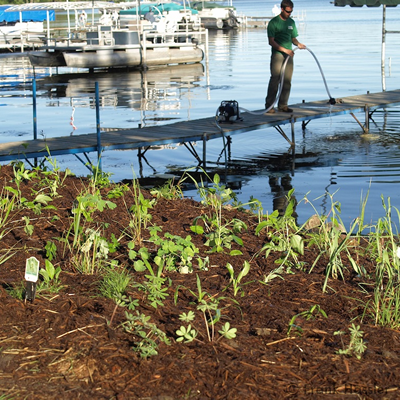
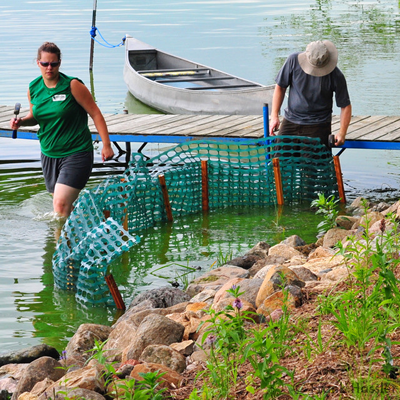
Protective, temporary fencing is installed around an emergent planting (left) and a freshly planted native shoreline buffer strip (right).
Other Ways to Protect Our Waters
Restoring your shoreline is a great place to start, but there are many other ways we can work to help protect your lake or stream and to make your property more healthy and natural.
Erosion Control: Stabilizing and revegetating degraded slopes.
Rain Gardens: A landscape feature that captures rainwater and infiltrates it into the ground.
Invasive Species Control: We control cattails, reed canary grass, purple loosestrife and other weeds of the water’s edge, and further inland.
Sustainable Landscaping: Focusing on managing water wisely, providing habitat for wild creatures, and beautiful views.
Prairie Planting: Replacing lawn with a prairie adds natural beauty to your property and protects water quality.